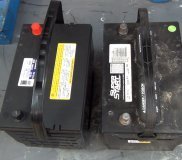Absolutely right, ... For any car other than a Volkswagen or BMW. Absolutely wrong in this case. I agree completely about touching battery cables but that is not an issue. They will already be disconnected from the battery to remove it. The nine volt transistor battery in the memory saver can not produce enough current to cause a spark and explosion hazard if the positive cable touches anything metal. What CAN happen is that shorts the voltage negating the entire purpose of the unit. That will not permanently damage anything but it WILL require a trip to the dealer. Most cigarette lighters and power outlets have 10 amp fuses, and if the battery cable is grounded, that transistor battery can't even muster enough current to blow those fuses. The industry standard to maintain the memories in the many computers with the ignition switch off is a maximum of 35 milliamps, (.035 amps) with a few car models allowing 50 milliamps. It's real easy for the transistor battery to deliver that. The stipulation is the ignition switch must be left off so that sad little battery won't be asked to run the radiator fan, heater fan, fuel pump, etc. The reason I prefer using a small battery charger is how do you get out of the car after plugging in the memory saver? You open a door and the interior lights go on. The transistor battery can't handle that. What about cars that have computers that need 20 minutes to go to "sleep mode"? Those cars can draw up to three amps after you park it in the shop and turn off the ignition switch. Do you think I'm going to fiddle around for 20 minutes before I start working on my customer's car?
You're right too about using a battery charger. I worried about sparks all the time but today most cars have hidden batteries and remote jump-starting terminals. The positive terminal is a long way from the battery but you still have to be careful to not let the positive battery cable touch ground.
This is way more than a radio preset issue. Every good mechanic will record them and re-enter them as a customer satisfaction concern. A memory saver will also maintain the short and long-term fuel trim numbers, (which the owner won't even notice if they're lost), but it also maintains the computer's memory for the adaptive learning on Chrysler computer-controlled transmissions. Even that is not a big deal. Stuff like that gets relearned on cars way back to the mid '80s. What we have NOT seen before is a manufacturer purposely designing in tricks to cost owners money after the sale, and VW is one of the worst offenders. GM is trying to catch up with some of their customer-unfriendly tricks.
Another example of VW's tricks is simply bumping the throttle under the hood with the engine running on their extremely dangerous throttle-by-wire systems. The throttle position sensor on the throttle body will not agree with the one on the accelerator pedal, and that will send it into fail-safe mode where it will not come off idle and may not come out of park. I've never run into that myself but I have no reason to doubt these warnings from a very high-level trainer with contacts at almost every world-wide manufacturer. This guy owns a business that only diagnoses cars that all the other shops have given up on. Their customers ARE those other shops, not the car owners directly. Their experiences are what they put in the classes they teach around the nation. Even VW mechanics have told them, do not disconnect the battery. A $900.00 tow and repair bill is not uncommon. For $900.00, I'll risk a tiny spark. You won't affect any other electronics on the car because the ignition switch is turned off. Even though the memory circuits remain alive, the computers are off. That's why they don't set fault codes when we unplug sensors and other things with just the ignition switch turned off and the battery still connected. Those memory circuits don't care if they get a steady 12 volts DC from the car battery, a steady 9 volts from a transistor battery, or a pulsing 15 volts from a battery charger. No computer will operate properly with only the pulsing voltage from a battery charger but with such a tiny current involved, it is real easy for the capacitors in the memory circuits to smooth those pulses out. Part of their purpose is to overcome the momentary dropouts in voltage caused by electromagnetic interference and the very troublesome voltage spikes caused by GM's generators. With all those capacitors have to do, they laugh at a little ripple from a battery charger.
There are other things a memory saver can't keep up with. One that comes to mind is the self-cleaning cycle on '80s Corvettes' mass air flow sensors 20 minutes after turning off the ignition switch. Even if that were to take place, all it would do is overheat and kill the nine volt battery, but it's doubtful anyone would even consider using a memory saver since they hadn't thought of locking-up computers yet.
I was pleasantly surprised to read that someone disconnected the battery on their 2008 GM car and everything worked later when they reconnected it. Still, I'm not going to tell anyone else that nothing will happen. We've never had cars like this before or the special procedures. We never used to have computers that locked up from just disconnecting the battery, and needed to be reprogrammed by the dealer.
Reread the very first sentence of this post. AlanSchlessman is one of very few people with the smarts to ask first rather than suffer the heartbreak later. Where have you ever read in any owner's manual before now a special warning about simply replacing the battery?
Thursday, November 8th, 2012 AT 10:09 AM





